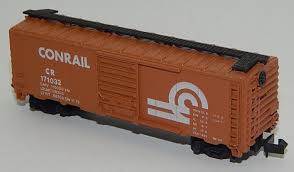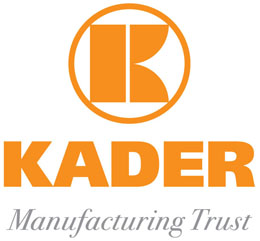Specific Item Information: This item was previously released under same reference with a Mehano mold.
Model Information: This Model Power tooling is a Chinese knock off of the New Jersey made 1976 vintage Atlas PS-1 boxcar. It was also imported by Life-Like. We are not sure of this was a deal struck between Model Power and Life-Like (who were presumably competitors) or if the Chinese factory simply decided to sell to Life-Like as well as Model Power. The Life-Like models are identical to the Model Power models.
Model Power re-ran their previous Mehano-made models with this new tooling, using the same roadnames and numbers and the same stock number. The main difference between the Mehano and the Chinese molds can be observed on the door. The best way to distinguish them remains however the marking on the under-frame (Yugoslavia or Hong-Kong)
This model is of equivalent quality to the Atlas version (perhaps even sharper molding and lettering). It likely appeared in the late 1980s when Model Power contracted with Chinese manufacturers to replicate various successful toolings from Europe (Roco, Lima) and the US (Atlas). Like all of this group of models, these care feature Rapido couplers attached to trucks with injection-molded plastic wheels. Most of these models look fine on a modern layout and will run well once you swap the Chinese trucks for MTL Bettendorf truck/couplers.
Model Power re-ran their previous Mehano-made models with this new tooling, using the same roadnames and numbers and the same stock number. The main difference between the Mehano and the Chinese molds can be observed on the door. The best way to distinguish them remains however the marking on the under-frame (Yugoslavia or Hong-Kong)
This model is of equivalent quality to the Atlas version (perhaps even sharper molding and lettering). It likely appeared in the late 1980s when Model Power contracted with Chinese manufacturers to replicate various successful toolings from Europe (Roco, Lima) and the US (Atlas). Like all of this group of models, these care feature Rapido couplers attached to trucks with injection-molded plastic wheels. Most of these models look fine on a modern layout and will run well once you swap the Chinese trucks for MTL Bettendorf truck/couplers.
Prototype History: The 40' Boxcar is widely known as one of the most popular freight cars used by railroads as they transitioned from steam to diesel. In particular the Pullman Standard or PS-1 design was one of the most popular and was widely used by North American railroads. These boxcars were built beginning in 1947 and share the same basic design, with certain elements such as door size, door style or roof type varying among the different railroads and production years. When production of these cars ceased in 1963, over 100,000 had been produced.
So just what is a PS-1? Well the simple answer is it is any boxcar built by Pullman Standard from 1947 on. The design changed over the years – sometimes subtly, sometimes for customer request, and sometimes in a larger way. In general, most PS-1’s built from 1947 to 1961 share the same dimensions and basic construction techniques. These cars all had a length of 40′, a height of 10’5″ or 10’6″, welded sides and ends and roof of Pullman’s own design. The greatest variation was in the size and style of doors used. Pullman Standard also offered 50′ and later 60′ boxcars – also with the PS-1 designation.
So just what is a PS-1? Well the simple answer is it is any boxcar built by Pullman Standard from 1947 on. The design changed over the years – sometimes subtly, sometimes for customer request, and sometimes in a larger way. In general, most PS-1’s built from 1947 to 1961 share the same dimensions and basic construction techniques. These cars all had a length of 40′, a height of 10’5″ or 10’6″, welded sides and ends and roof of Pullman’s own design. The greatest variation was in the size and style of doors used. Pullman Standard also offered 50′ and later 60′ boxcars – also with the PS-1 designation.
Road Name History: The Consolidated Rail Corporation, commonly known as Conrail (reporting mark CR), was the primary Class I railroad in the Northeast U.S. between 1976 and 1999. Conrail is a portmanteau of "consolidated" and "rail" from the name of the company.
The U.S. federal government created Conrail to take over the potentially profitable lines of multiple bankrupt carriers, including the Penn Central Transportation Company and Erie Lackawanna Railway. With the benefit of industry-wide regulatory requirements being reduced (via the 4R Act and the Staggers Act), Conrail began to turn a profit in the 1980s and was turned over to private investors in 1987. The two remaining Class I railroads in the East, CSX Transportation and the Norfolk Southern Railway (NS), agreed in 1997 to split the system approximately equally, returning rail freight competition to the Northeast by essentially undoing the 1968 merger of the Pennsylvania Railroad and New York Central Railroad that created Penn Central. Following Surface Transportation Board approval, CSX and NS took control in August 1998, and on June 1, 1999, began operating their portions of Conrail.
The U.S. federal government created Conrail to take over the potentially profitable lines of multiple bankrupt carriers, including the Penn Central Transportation Company and Erie Lackawanna Railway. With the benefit of industry-wide regulatory requirements being reduced (via the 4R Act and the Staggers Act), Conrail began to turn a profit in the 1980s and was turned over to private investors in 1987. The two remaining Class I railroads in the East, CSX Transportation and the Norfolk Southern Railway (NS), agreed in 1997 to split the system approximately equally, returning rail freight competition to the Northeast by essentially undoing the 1968 merger of the Pennsylvania Railroad and New York Central Railroad that created Penn Central. Following Surface Transportation Board approval, CSX and NS took control in August 1998, and on June 1, 1999, began operating their portions of Conrail.
Brand/Importer Information: Founded in the late 1960's by Michael Tager, the 3rd generation business specializes in quality hobby products serving the toy and hobby markets worldwide. During its 50 years of operation, Model Power has developed a full line of model railroading products, die-cast metal aircraft, and die-cast metal cars and trucks.
In early 2014, Model Power ceased its business operations. Its extensive portfolio of intellectual property and physical assets are now exclusively produced, marketed, sold, and distributed by MRC (Model Power, MetalTrain and Mantua) and by Daron (Postage Stamp Airplanes and Airliner Collection).
In early 2014, Model Power ceased its business operations. Its extensive portfolio of intellectual property and physical assets are now exclusively produced, marketed, sold, and distributed by MRC (Model Power, MetalTrain and Mantua) and by Daron (Postage Stamp Airplanes and Airliner Collection).
Manufacturer Information: Kader Industrial Company Limited was founded in Hong Kong in 1948 by Ting Hsiung Chao. It was listed on the Hong Kong Stock Exchange in 1985 and presently trades under the name of "Kader Holdings Company Limited".
The company today is one of the world's largest manufacturers of toy and hobby railways, and also has wider manufacturing interests as well as substantial investments in property. The vision of Mr. Ting Hsiung Chao is shared by the Ting family, which continues to lead the Kader Group. Kader's initial focus product was to manufacture plastic flashlights, which at the time were a novelty.
The company today is one of the world's largest manufacturers of toy and hobby railways, and also has wider manufacturing interests as well as substantial investments in property. The vision of Mr. Ting Hsiung Chao is shared by the Ting family, which continues to lead the Kader Group. Kader's initial focus product was to manufacture plastic flashlights, which at the time were a novelty.
Item created by: Alain LM on 2017-10-05 15:34:48. Last edited by gdm on 2020-07-24 07:29:15
If you see errors or missing data in this entry, please feel free to log in and edit it. Anyone with a Gmail account can log in instantly.
If you see errors or missing data in this entry, please feel free to log in and edit it. Anyone with a Gmail account can log in instantly.












